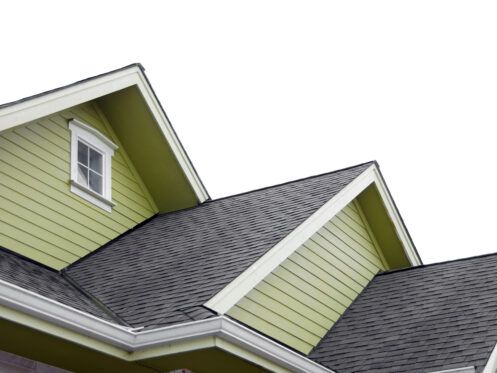Apart from cleaning your gutters in late fall and early spring, you probably don’t pay much attention to the area where your roof is located. Despite being out of sight and frequently out of mind, your roof plays a major role in protecting your Alpha, NJ, home and all that it contains. Identifying the early signs of roof deterioration will allow you to catch and correct small problems before they spiral out of control.
It will also give you a better opportunity to plan and prepare for roof replacement rather than making hasty, last-minute decisions. The following are eight changes to watch out for as your roof weathers the elements and grows older.
1. Dark Patches
Some roofing problems are easy to detect from the curb. For instance, if you look up at your roof while standing in your front yard, you might notice one or more dark, discolored patches. In most cases, these are areas in which asphalt shingles are losing their protective granules. Far more than just an aesthetic issue, shingle granule loss leaves these components vulnerable to the ravages of the sun’s UV rays. In addition to offering UV-ray protection, shingles help route water off the building and into gutters and downspouts.
When new, asphalt shingles are flexible enough to withstand strong wind forces and significant pressure without cracking or breaking. When shingles age and experience granule loss as the result of normal wear, they’re often dry, brittle, and quickly deteriorating. Depending on the age and overall condition of your roof, this is an issue that could warrant immediate replacement by a professional.
Dark Patches and the Development of Mold
Not all dark spots on roofs are the result of shingle granule loss. If you have large, black patches on your roof, these could be buildups of moss or mold. Both issues are an indication of excess humidity, poor drainage, or other moisture problems. More importantly, both require the attention of a professional roofer. Attempting to power wash your roof could cause additional harm given that high-pressure washing systems can bend, lift, or completely remove shingles. Shingle damage is all the more likely during power washing when these features are already aged and brittle.
2. Shingle Granules in Your Gutters or at the Base of Your Downspouts
Another way to identify problems with missing shingle granules is by inspecting the matter that collects at the base of your downspouts. Look for small, dark-colored pebbles. You can also check the contents of your gutters when clearing out leaves. In some instances, topical applications can restore vitality to aging shingles, increase their flexibility, and slightly extend their lifespan. A professional can help you determine what kind of service can be done to protect the integrity of your shingles.
3. Flashing Problems
Flashing is a thin layer of galvanized steel, copper, or other metal that’s used to route water away from vulnerable areas. You’ll find it located around your chimneys, vents, and other openings or protrusions. You’ll also see small amounts of flashing in your roof’s valleys where two sections of this system meet.
Flashing should provide watertight seals at or around these features. If it’s bent, torn, pulling away, or increasingly exposed, you need flashing repairs. However, when there’s visible separation at the roof valleys and two intersecting roof sections are pulling apart, it’s probably time for a full roof replacement. A roofing professional can assess your flashing and let you know what the best course of action is.
4. Soft, Spongy Areas That Feel Springy Underfoot
Homeowners are advised against climbing onto their roofs to inspect what’s going on up there. When roofers mount roofs during inspections and repairs, they look for soft, spongy areas. When a roof feels springy underfoot, this means that water has found a way in. Even if you don’t have water spots on your ceilings, active leaks indoors, blistered paint, or other leak-related issues, a spongy, springy roof is evidence of water damage.
Residential roofs are multi-layered systems. When water gets past shingles and underlayment, it saturates wood roof decking. Over time, this causes the decking and rough framing to soften and warp, which often leads to serious mold issues.
5. Recurring Pest Problems
Leaky, aging roofs are incredibly attractive to pests. Given that they’re often riddled with moisture and rotting debris, they provide the perfect breeding grounds for ants, mosquitoes, and other insects. Having a rotting substrate can also attract termites to a building.
Severely damaged roofs provide more viable points of ingress for squirrels, rats, mice, bats, and owls than intact roofs. If you’re constantly battling rooftop or attic infestations, an aging or poorly maintained roof is the most likely culprit.
6. Curling Shingles
Strong winds and heavy precipitation can cause shingle damage. After a big storm, you might notice a few loose or missing shingles. Scheduling storm damage repairs is the best way to prevent minor and localized issues from impacting a much larger space. However, if you step outside and notice that a large majority of your shingles are curling, you have a far more serious problem on your hands.
After years of being subjected to UV rays, temperature changes, and moisture, asphalt shingles shrink and become increasingly brittle. The result is progressive cupping and curling that leaves the underlayment unprotected. Unlike a single, bent shingle that can be straightened and nailed back down or replaced, curling shingles often indicate the need for roof replacement.
Widespread Shingle Loss
Many homeowners need to have several shingles replaced after each storm season. Widespread shingle loss can be a sign of advanced aging. There may be non-weather-related problems affecting your roof’s integrity. More often than not, widespread shingle loss is the result of increasingly brittle, fragile shingles.
7. Raised or Exposed Roof Nails
When roofs are properly installed, you shouldn’t be able to see raised or exposed nails. When nails pop out of position and fall off the roof, they pose the risk of tire damage and physical injury. More importantly, missing nails leave behind tiny perforations in roofs that allow moisture in. During annual roof inspection services, professionals look for and replace missing nails. It’s also important to check for age-related wear and moisture damage. Having rotting and warped roof decking could force nails out of position.
8. Warped or Discolored Siding
If your siding is warped or discolored, the problem could lie with your roof. This is an indication that your roof is no longer routing precipitation into your gutters and downspouts or that your rooftop drainage system is leaking or overflowing. You might have shingles that have completely lost their granules or superficial leaks that are redirecting water toward your siding.
For asphalt shingle roofs, it’s best to start planning for roof replacement when your roof is between 20 and 25 years of age. Having a roofing company track your roof’s remaining lifespan through regular inspections, maintenance, and repairs will help you avoid sudden roofing collapse and failure.
Since 1973, Warren Thompson & Son Roofing & Siding has been proudly serving Alpha and the surrounding cities. We offer residential roof replacement, repairs, and inspection services. We can also replace your siding, install gutters, and take care of emergency repairs. To schedule an appointment, get in touch with Warren Thompson & Son Roofing & Siding today.

